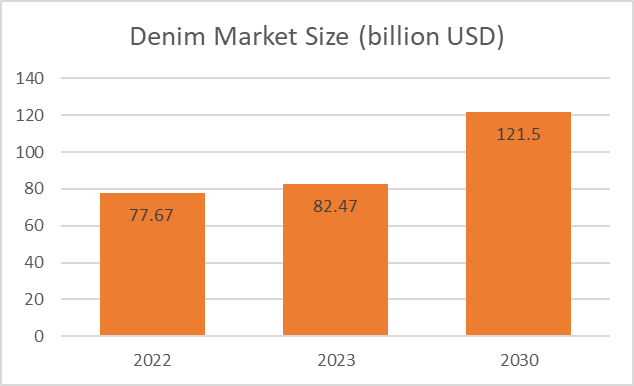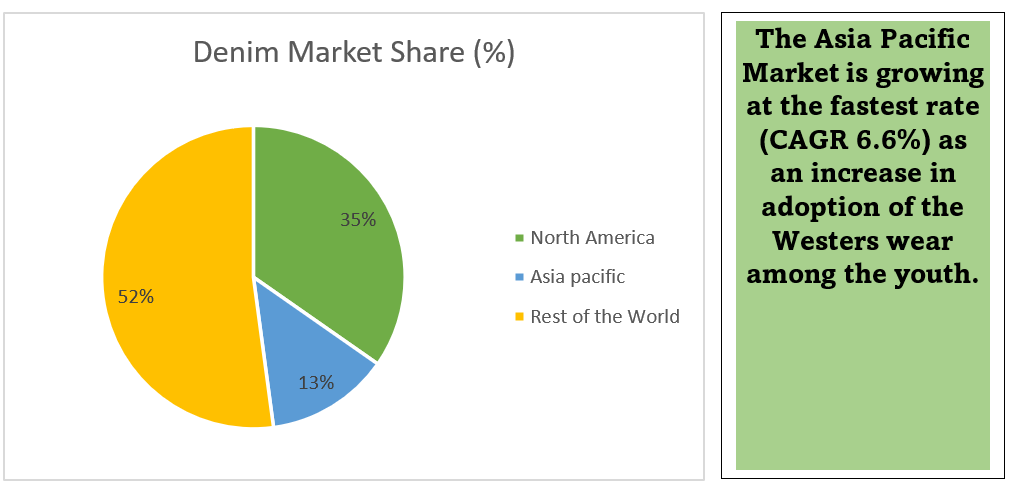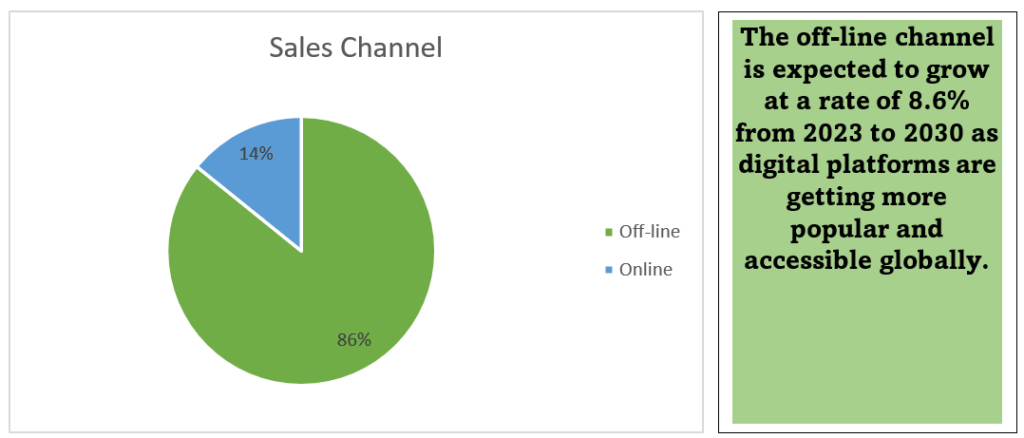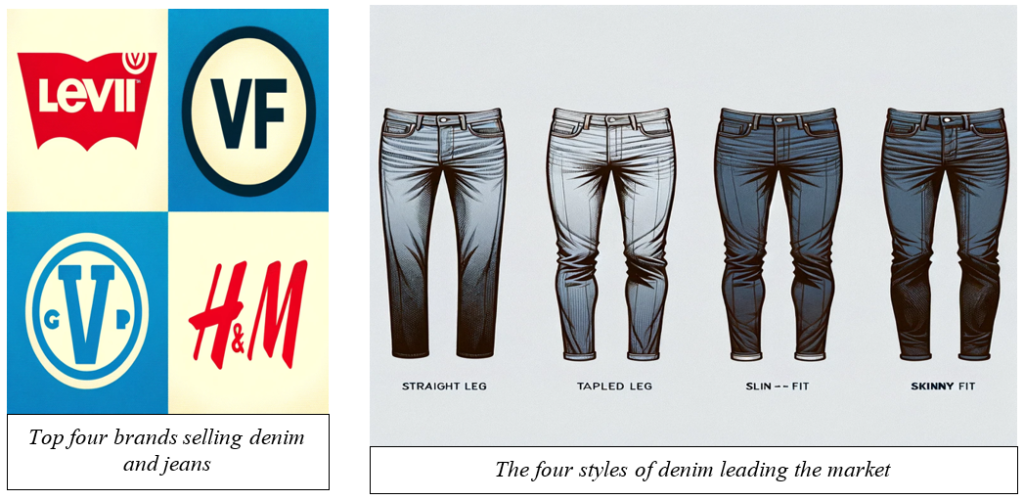Denim and jeans industry is a niche industry characterized by continued growth in size and diversity. Denim, as a cornerstone in the fashion industry is accepted by consumers all over the world irrespective of age, gender and weather. In an era defined by both challenges and innovation, the denim industry stands as a paradigm ofa adaptability and foresight. As we weave through the data threads from 2022 and cast an eye towards 2023, a story of growth and evolution emerges, sketched on the rich fabric of the global denim market.
Growing Market Size and Change in Dynamics
The global denim market has been displaying a significant growth pattern and is expected to continue doing so in the coming years. As of 2022, the market size was valued at USD 77.67 billion and is projected to grow at a compound annual growth rate (CAGR) of 5.8% from 2023 to 2030, reaching an estimated USD 121.50 billion by the end of the forecast period.
A breakdown of the denim market by distribution channels reveals that offline sales dominated the market in 2022, with an 85.8% share. Despite this, the online sales channel is expected to grow at a CAGR of 8.6% from 2023 to 2030, suggesting a shift towards digital platforms driven by the popularity of e-commerce websites and increasing internet penetration.
 Regarding end-user segmentation, the men’s segment held a significant market share in 2022, with a preference for styles such as straight leg, tapered leg, slim fit, and skinny. However, there’s also a growing demand for women’s denim, influenced by a rise in spending on personal care and apparel.
Regarding end-user segmentation, the men’s segment held a significant market share in 2022, with a preference for styles such as straight leg, tapered leg, slim fit, and skinny. However, there’s also a growing demand for women’s denim, influenced by a rise in spending on personal care and apparel.
Regionally, North America accounted for a 34.7% share of the market in 2022, owing to the influence of popular global brands and their fashion innovations. Meanwhile, the Asia Pacific region is projected to be the fastest growing with a CAGR of 6.6%, attributed to the expansion strategies of multinational corporations and an increase in the adoption of Western wear among the youth.



The competitive landscape in the denim market is robust, with key players such as Levi Strauss & Co., VF Corp., The Gap, Inc., and H&M engaging in various strategies like mergers, acquisitions, and research and development to capture larger market shares and adapt to consumer demands.
With social media’s growing influence and the global apparel market’s continuous evolution, the denim jeans market is poised for a bright future, shaping consumer trends and fashion preferences on a worldwide scale.
Sustainability and the Future
The denim industry has reached an inflection point where sustainability is no longer a niche trend but an integral part of its future. As consumers become more environmentally conscious, there is an increasing demand for the fashion industry to adopt green practices. Here’s an overview of the strides being made in sustainability within the denim sector:
Sustainable Manufacturing Technologies
Denim production traditionally has a significant environmental footprint, involving intensive water usage, chemical dyes, and generating a considerable amount of waste. However, manufacturers are now embracing innovative technologies that promise a greener production process:
Water Conservation: Technologies such as foam dyeing reduce water usage by over 90% compared to traditional dyeing methods. Water recycling systems are also being implemented, allowing factories to reuse much of their water.
Eco-friendly Dyes: There’s a shift towards using natural, plant-based dyes and advanced dyeing techniques that minimize the toxic impact on the environment.
Energy Efficiency: Adoption of renewable energy sources, such as solar and wind, to power manufacturing processes is on the rise, decreasing the carbon footprint of denim production.
Biodegradable Materials: Research and development are ongoing in creating biodegradable denim to ensure that jeans at the end of their lifecycle do not persist in landfills.
Green Distribution Channels.
Sustainability extends to the logistics and distribution of denim, with brands exploring eco-friendly packaging and efficient transportation:
Reduced Packaging: Many companies are reducing or eliminating unnecessary packaging, shifting to materials that are recyclable or compostable.
Carbon-Neutral Shipping: Brands partner with shipping companies that offset carbon emissions through various environmental projects.
Local Production: To cut down on emissions associated with long-distance transportation, some brands are turning to nearshoring, producing closer to their primary markets.
Addressing Denim Waste
The denim industry generates significant post-industrial and post-consumer waste. In response, there are concerted efforts to reduce, reuse, and recycle:
Recycling Programs: Brands are introducing take-back schemes where consumers can return their old jeans for recycling or resale.
Upcycled Denim: Designers are creating new products from denim waste, giving life to unique fashion items without additional raw material extraction.
Circular Fashion Models: There’s a push towards a circular economy in denim, where products are designed to be reused and eventually recycled back into new fabrics.
Recycled PET in Denim
One of the most innovative approaches to sustainability in the denim industry is the incorporation of recycled PET (polyethylene terephthalate) bottles into the fabric. This process involves:
Breaking Down: Plastic bottles are collected, sorted, and cleaned before being shredded into flakes.
Spinning into Yarn: The flakes are then melted and spun into polyester fiber, which can be blended with cotton to create denim fabric.
Resource Efficiency: Using recycled PET reduces dependency on virgin plastics, conserves petroleum resources, and diverts plastic waste from landfills.
Consumer Awareness
Brands are educating consumers about the value of recycled materials in their products, which not only conserves resources but also tackles the problem of plastic pollution.
In conclusion, the future of the denim industry is being reimagined with a focus on sustainability. Through the adoption of sustainable manufacturing practices, greener distribution channels, innovative waste management, and the use of recycled materials, the industry is setting a new standard that aligns profitability with planetary health. This green transition is not just transforming the industry from the inside out but is also reshaping consumer expectations and the broader fashion ecosystem.
References:
- Denim Industry Market Trends, Grand View Research, https://www.grandviewresearch.com/industry-analysis/denim-jeans-market
- Data Bridge Market Research, https://www.databridgemarketresearch.com/reports/asia-pacific-denim-jeans-market
- “Innovation in Denim: Sustainable Technologies Taking Over” – Apparel Resources.
- “The Rise of Circular Denim: Recycling and Reuse in Fashion” – Eco Textile News.
“Green Jeans: How Denim is Driving Fashion’s Sustainability Movement” – Business of Fashion.








